
Goldshore Expands Gold Mineralization Along Strike and at Depth at the Southwest Zone
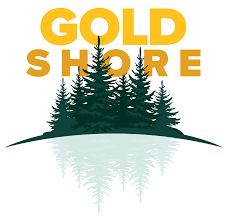
Includes Intersects 2.17 g/t Au over 50.35m and 6.96 g/t Au over 15.05m
Goldshore Resources Inc. (TSX-V: GSHR) (OTCQB: GSHRF) (FWB: 8X00) is pleased to announce assay results from its recently completed drill program at the Moss Lake Project in Northwest Ontario, Canada.
Highlights:
- Results from seven holes testing the extension of the Southwest Zone toward the Main Zone have delineated a new high-grade lens, including visible gold, northeast of the Southwest Zone resource that extends from surface to at least 250 meters depth with best intercepts of:
- 6.96 g/t Au over 15.05m from 189.4m depth in MMD-22-105, including
- 54.4 g/t Au over 1.6m from 189.4m
- 2.17 g/t Au over 50.35m from 103.55m depth in MMD-23-114, including
- 3.47 g/t Au over 26.05m from 120.35m
- 1.30 g/t Au over 21.35m from 214m depth in MMD-22-108, including
- 2.60 g/t Au over 7.35 from 228.0m
- 6.96 g/t Au over 15.05m from 189.4m depth in MMD-22-105, including
- These drill results prove that the Southwest Zone is a continuation of the Main Zone and not a fault offset as previously interpreted. They also show that the Southwest Zone extends to depth and is potentially as large as the Main Zone.
With drilling recently completed, the Company is preparing an updated mineral resource expected in May. The updated resource will use data from an additional 72 holes compared to the November 2022 resource. Mineralization in the resource area remains open in multiple directions.
President and CEO Brett Richards stated: “These results continue to support our belief that the size and scale of the Moss Gold Project is much larger and continues to be open at all directions, along strike both to the northeast and southwest, as well as our understanding of lateral mineralized targets to the south-east of the Southwest Zone and the Main Zone. For now, we have halted the program to step back; understand the quantum of this resource, and prepare for a mineral resource update in early May, we can now see a viable path to a meaningful project PEA (preliminary economic analysis). We look forward to those results in the coming months, as we start to plan for an infill drilling program working towards a pre-feasibility study in the future.”
Technical Overview
Figure 1 shows the location of the drill holes in this press release and Figure 2 shows a close up of the drilled area with significant intercepts. Figure 3 is a typical section through hole MMD-22-105, -108 and -109. Table 1 shows the significant intercepts. Table 2 shows the drill hole locations.
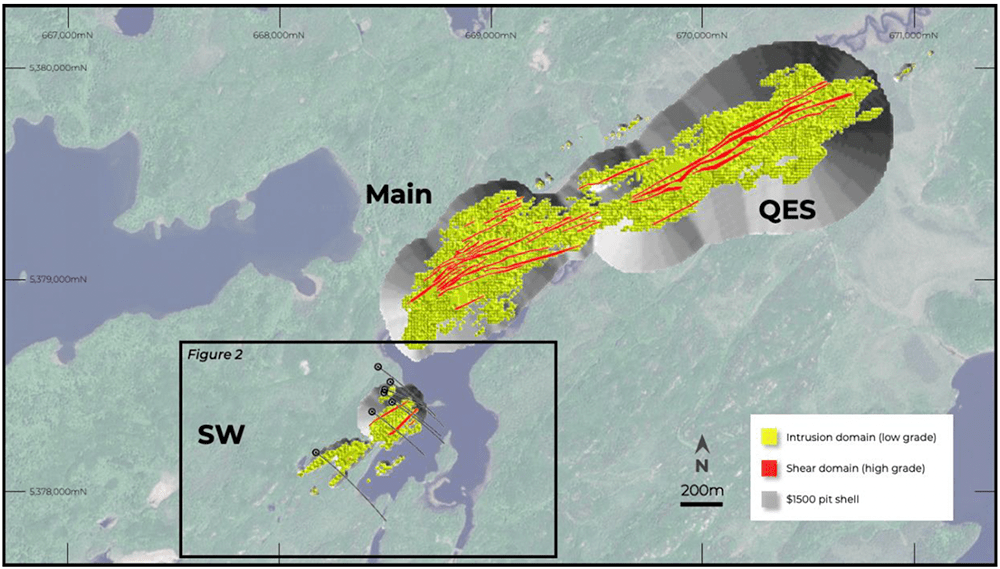
Figure 1: Location of drill holes in this release relative to the November 2022 resource model and $1500 open pit shell constraint
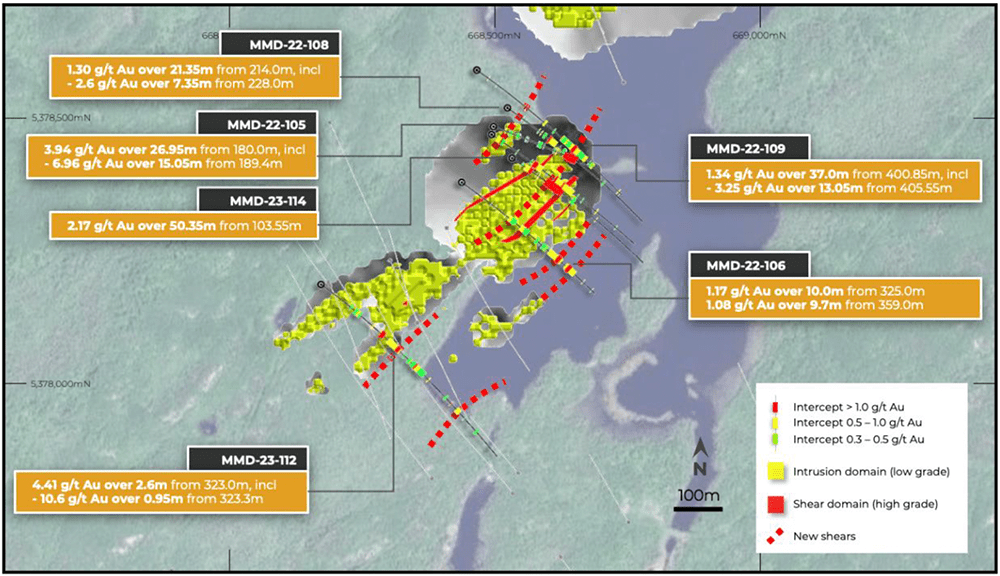
Figure 2: insert close up of Southwest Zone with significant intercepts relative to the November 2022 resource model and $1500 open pit shell constraint

Figure 3: Drill section through holes MMD-22-105, -108 and -109 showing the significant expansion of the mineralized model beneath the November 2022 resource model and $1500 open pit shell constraint, which should add to mineral resources in the upcoming update
Continued infill of the Southwest Zone has delineated a new continuous high-grade structure over a 250m strike length from near surface to 200m depth immediately northeast of the historical Southwest Zone. Holes MMD-22-105, -108, -109 and MMD-23-113, and -114 intersected this structure along with previously released holes MMD-22-031, -042, -063, and -064. The newly understood zone orientation was tested against the phase 1 drill results and confirmed the continuity of the high-grade structures controlling the mineralization.
The mineralized zone occurs within an albitite+hematite altered diorite intrusion complex cut by closely spaced, texturally destructive sericite+chlorite+carbonate altered shears. Additional shearing, and subsequent alteration, is seen extending into the neighboring intermediate volcanics but is poorly mineralized.
The gold mineralization appears more nuggety than elsewhere in the deposit with a greater portion of the mineralization attributed to pyrite±chalcopyrite bearing quartz-carbonate veins within the sheared intervals. Mineralization includes visible gold (Figure 4). Several very high-grade intercepts include:
- 54.4 g/t Au over 1.6m from 189.4m depth in MMD-22-105
- 11.3 g/t Au over 0.5m from 147.7m depth in MMD-22-108 and
- 11.5 g/t Au over 0.7m from 232.35m
- 10.6 g/t Au over 0.95m from 323.3m depth in MMD-23-112
- 19.0 g/t Au over 0.65m from 54m depth in MMD-23-114 and
- 22.9 g/t Au over 1m from 128m depth and
- 14.4 g/t Au over 1m from 137m depth
Holes MMD-22-109 and MMD-23-113 intersected the high-grade structure but encountered lesser vein mineralization resulting in more modest grade intercepts including:
- 0.44 g/t Au over 81.2m from 298.8m depth in MMD-22-109, including
- 1.08 g/t Au over 8.60m from 335.35m
- 0.63 g/t Au over 29.5m from 129.55m depth in MMD-23-113, including
- 4.76 g/t Au over 2.0m from 140.0m and
- 0.51 g/t Au over 58m from 204.0m depth, including
- 1.92 g/t Au over 4.0m from 205.0m and
- 1.84 g/t Au over 3.0m from 229.0m
Holes MMD-22-106, and MMD-23-112 were focused on infilling the drill spacing of the existing Southwest Zone. All three holes intercepted broad zones of mineralization hosted primarily within altered granodiorite containing narrow higher grade shear zones. Best intercepts include:
- 0.47 g/t Au over 63m from 277m depth in MMD-22-106
- 0.61 g/t Au over 41.25m from 232m depth in MMD-23-112
0.39 g/t Au over 53.5m from 301m depth in MMD-23-112
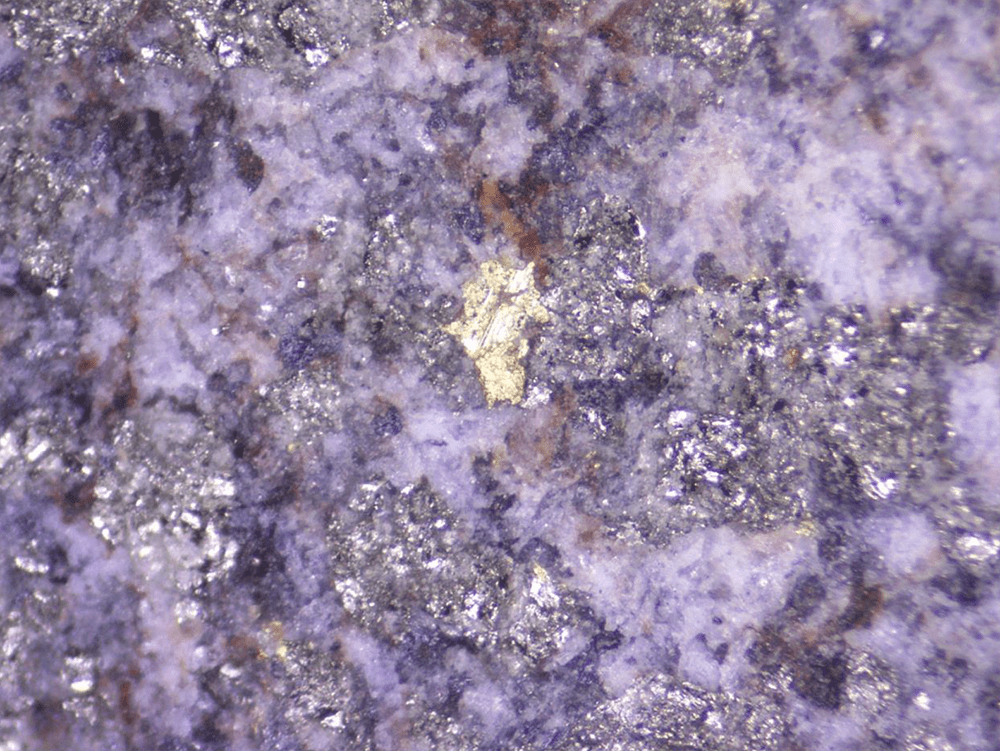
Figure 1: Visible gold flake within a quartz-carbonate-pyrite vein at 190.42m (1.6m @ 54.4 g/t Au) in MMD-22-105 within the sheared, altered intrusion of the Southwest zone. Note that this photo is not intended to be representative of broader mineralization on the Moss Lake Gold Project.
Pete Flindell, VP Exploration for Goldshore, said “These results show that the Southwest Zone is much larger and better mineralized than historical drillholes suggested; and is potentially as large as the Main Zone. We await the results from the final batch of assays that are expected to provide critical infill beneath the heart of the Southwest Zone.”
Table 1: Significant downhole gold intercepts
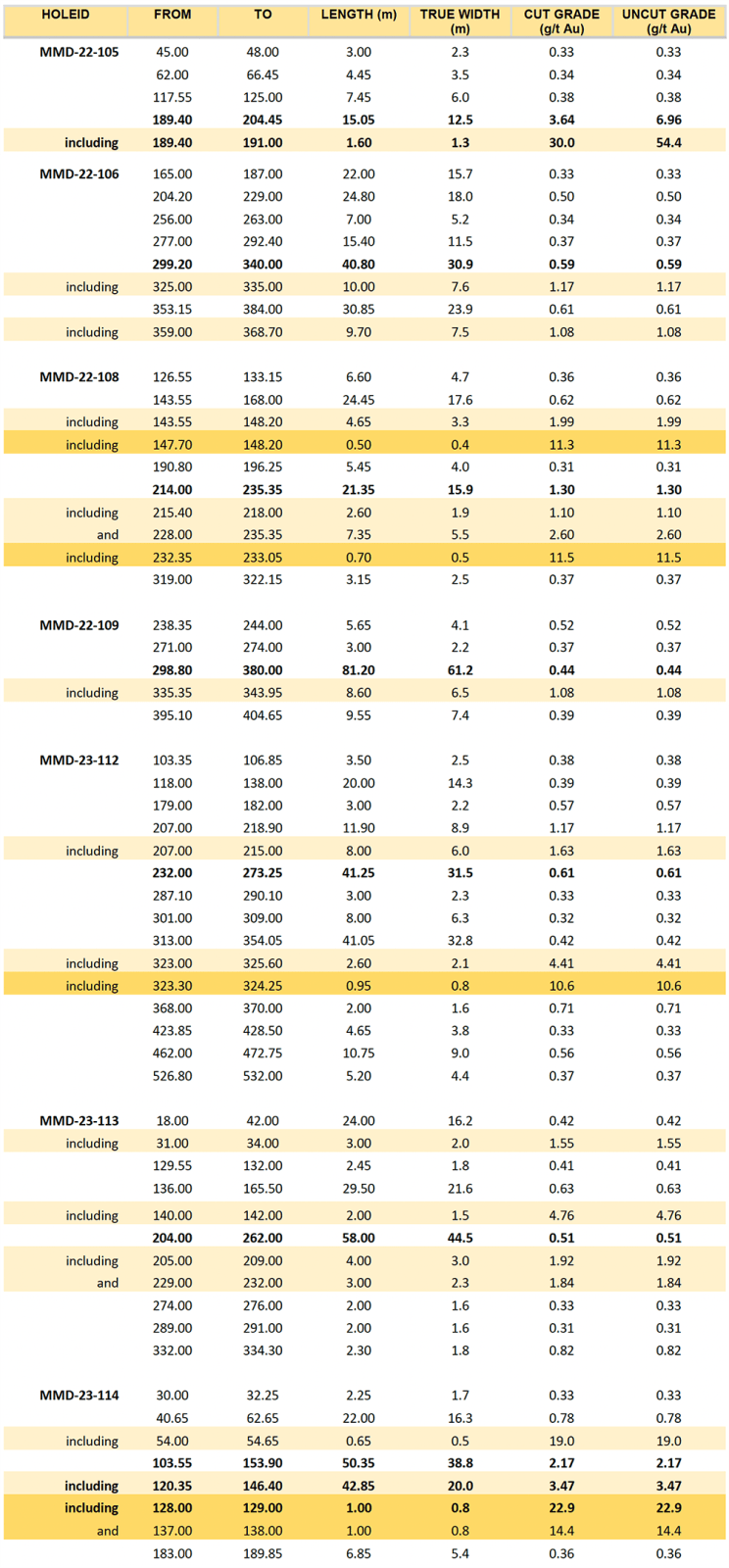
Intersections calculated above a 0.3 g/t Au cut off with a top cut of 30 g/t Au and a maximum internal waste interval of 10 metres. Shaded intervals are intersections calculated above a 1.0 g/t Au cut off. Intervals in bold are those with a grade thickness factor exceeding 20 gram x metres / tonne gold. True widths are approximate and assume a subvertical body.
Table 2: Location of drill holes in this press release
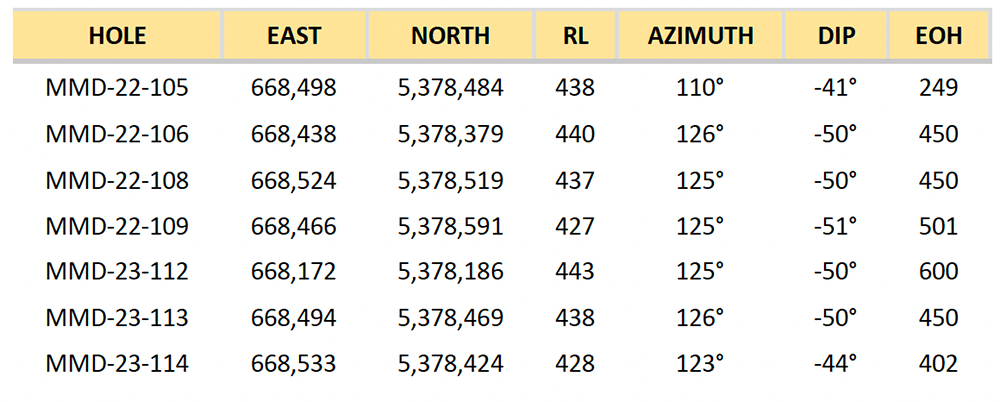
Analytical and QA/QC Procedures
All samples were sent to ALS Geochemistry in Thunder Bay for preparation and analysis was performed in the ALS Vancouver analytical facility. ALS is accredited by the Standards Council of Canada (SCC) for the Accreditation of Mineral Analysis Testing Laboratories and CAN-P-4E ISO/IEC 17025. Samples were analyzed for gold via fire assay with an AA finish (“Au-AA23”) and 48 pathfinder elements via ICP-MS after four-acid digestion (“ME-MS61”). Samples that assayed over 10 ppm Au were re-run via fire assay with a gravimetric finish (“Au-GRA21”).
In addition to ALS quality assurance / quality control protocols, Goldshore has implemented a quality control program for all samples collected through the drilling program. The quality control program was designed by a qualified and independent third party, with a focus on the quality of analytical results for gold. Analytical results are received, imported to our secure on-line database and evaluated to meet our established guidelines to ensure that all sample batches pass industry best practice for analytical quality control. Certified reference materials are considered acceptable if values returned are within three standard deviations of the certified value reported by the manufacture of the material. In addition to the certified reference material, certified blank material is included in the sample stream to monitor contamination during sample preparation. Blank material results are assessed based on the returned gold result being less than ten times the quoted lower detection limit of the analytical method. The results of the on-going analytical quality control program are evaluated and reported to Goldshore by Orix Geoscience Inc.
About Goldshore
Goldshore is an emerging junior gold development company, and owns 100% of the Moss Gold Project located in Ontario. Wesdome is currently a large shareholder of Goldshore with an approximate 22% equity position in the Company. Well-financed and supported by an industry-leading management group, board of directors and advisory board, Goldshore is positioned to advance the Moss Gold Project through the next stages of exploration and development.
Peter Flindell, P.Geo., MAusIMM, MAIG, Vice President – Exploration of the Company, a qualified person under NI 43-101 has approved the scientific and technical information contained in this news release.
MORE or "UNCATEGORIZED"
Kuya Silver Confirms High-Grade Silver-Gold Vein Mineralization at Umm-Hadid with Initial Drill Results up to 1483.9 g/t AgEq over 2 Metres
Kuya Silver Corporation (CSE: KUYA) (OTCQB: KUYAF) (FSE: 6MR1) is... READ MORE
First Phosphate Closes Final Tranche of Oversubscribed Private Placement
First Phosphate Corp. (CSE: PHOS) (OTCQX: FRSPF) (FSE: KD0) is... READ MORE
GFG Receives Final Payment from the Sale of its Rattlesnake Hills Gold Project
GFG Resources Inc. (TSX-V: GFG) (OTCQB: GFGSF) announces that i... READ MORE
Goliath Receives $1,730,882 Through Warrant Exercises, Inclusive Of Crescat Capital A Longtime Strategic And Cornerstone Shareholder
Goliath Resources Limited (TSX-V: GOT) (OTCQB: GOTRF) (FSE: B4IF)... READ MORE
Robex Pours First Gold at Kiniéro on Schedule and Budget
Highlights: Gold bar weighing 2.64 kilograms (85 oz) poured in th... READ MORE












